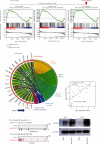The Long Noncoding Transcript HNSCAT1 Activates KRT80 and Triggers Therapeutic Efficacy in Head and Neck Squamous Cell Carcinoma
- PMID: 35965679
- PMCID: PMC9371835
- DOI: 10.1155/2022/4156966
The Long Noncoding Transcript HNSCAT1 Activates KRT80 and Triggers Therapeutic Efficacy in Head and Neck Squamous Cell Carcinoma
Abstract
Head and neck squamous carcinoma (HNSC) is the most prevalent malignancy of the head and neck regions. Long noncoding RNAs (lncRNAs) are vital in tumorigenesis regulation. However, the role of lncRNAs in HNSC requires further exploration. Herein, through bioinformatic assays using The Cancer Genome Atlas (TCGA) datasets, rapid amplification of cDNA ends (RACE) assays, and RNA-FISH, we revealed that a novel cytoplasmic transcript, HNSC-associated transcript 1 (HNSCAT1, previously recognized as linc01269), was downregulated in tumor samples and advanced tumor stages and was also associated with favorable outcomes in HNSC. Overexpression of HNSCAT1 triggered treatment efficacy in HNSCs both in vivo and in vitro. More importantly, through high-throughput transcriptome analysis (RNA-seq, in NODE database, OEZ007550), we identified KRT80, a tumor suppressor in HNSC, as the target of HNSCAT1. KRT80 expression was modulated by lncRNA HNSCAT1 and presented a positive correlation in tumor samples (R = 0.52, p < 0.001). Intriguingly, we identified that miR-1245 simultaneously interacts with KRT80 and HNSCAT1, which bridges the regulatory function between KRT80 and HNSCAT1. Conclusively, our study demonstrated that lncRNA HNSCAT1 functions as a necessary tumor inhibitor in HNSC, which provides a novel mechanism of lncRNA function and provides alternative targets for the diagnosis and treatment of HNSC.
Copyright © 2022 Yixuan Zhao et al.
Conflict of interest statement
The authors declare that they have no competing interests.
Figures







Similar articles
-
Excavating novel diagnostic and prognostic long non-coding RNAs (lncRNAs) for head and neck squamous cell carcinoma: an integrated bioinformatics analysis of competing endogenous RNAs (ceRNAs) and gene co-expression networks.Bioengineered. 2021 Dec;12(2):12821-12838. doi: 10.1080/21655979.2021.2003925. Bioengineered. 2021. PMID: 34898376 Free PMC article.
-
Identification of a nomogram based on an 8-lncRNA signature as a novel diagnostic biomarker for head and neck squamous cell carcinoma.Aging (Albany NY). 2020 Oct 22;12(20):20778-20800. doi: 10.18632/aging.104014. Epub 2020 Oct 22. Aging (Albany NY). 2020. PMID: 33091878 Free PMC article.
-
CCND1-associated ceRNA network reveal the critical pathway of TPRG1-AS1-hsa-miR-363-3p-MYO1B as a prognostic marker for head and neck squamous cell carcinoma.Sci Rep. 2023 Jul 22;13(1):11831. doi: 10.1038/s41598-023-38847-7. Sci Rep. 2023. PMID: 37481637 Free PMC article.
-
Long noncoding RNAs in head and neck squamous cell carcinoma: biological functions and mechanisms.Mol Biol Rep. 2020 Oct;47(10):8075-8090. doi: 10.1007/s11033-020-05777-w. Epub 2020 Sep 10. Mol Biol Rep. 2020. PMID: 32914266 Review.
-
Long non-coding RNAs orchestrate various molecular and cellular processes by modulating epithelial-mesenchymal transition in head and neck squamous cell carcinoma.Biochim Biophys Acta Mol Basis Dis. 2021 Nov 1;1867(11):166240. doi: 10.1016/j.bbadis.2021.166240. Epub 2021 Aug 5. Biochim Biophys Acta Mol Basis Dis. 2021. PMID: 34363933 Review.
Cited by
-
COADREADx: A comprehensive algorithmic dissection of colorectal cancer unravels salient biomarkers and actionable insights into its discrete progression.PeerJ. 2024 Oct 28;12:e18347. doi: 10.7717/peerj.18347. eCollection 2024. PeerJ. 2024. PMID: 39484215 Free PMC article.
-
The facilitating effects of KRT80 on chemoresistance, lipogenesis, and invasion of esophageal cancer.Cancer Biol Ther. 2024 Dec 31;25(1):2302162. doi: 10.1080/15384047.2024.2302162. Epub 2024 Jan 19. Cancer Biol Ther. 2024. PMID: 38241178 Free PMC article.
-
A New Cuproptosis-Related lncRNAs Model for Predicting the Prognosis of Hepatitis B Virus-Associated Hepatocellular Carcinoma and Experimental Validation of LINC01269.Int J Gen Med. 2024 Dec 10;17:6009-6027. doi: 10.2147/IJGM.S489059. eCollection 2024. Int J Gen Med. 2024. PMID: 39678673 Free PMC article.
-
The Two Faces of Immune-Related lncRNAs in Head and Neck Squamous Cell Carcinoma.Cells. 2023 Feb 24;12(5):727. doi: 10.3390/cells12050727. Cells. 2023. PMID: 36899863 Free PMC article. Review.
-
A cuproptosis-related lncRNA signature predicts the prognosis and immune cell status in head and neck squamous cell carcinoma.Front Oncol. 2023 Jul 19;13:1055717. doi: 10.3389/fonc.2023.1055717. eCollection 2023. Front Oncol. 2023. PMID: 37538124 Free PMC article.
References
MeSH terms
Substances
LinkOut - more resources
Full Text Sources
Medical

